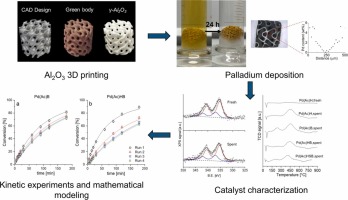Luca Mastroianni, Giuseppe Agovino, Francesco Sandri, Atte Aho, Kari Eränen, Sergio Cassese, Stefano Mungiguerra, Martino Di Serio, Dmitry Yu Murzin, Vincenzo Russo, Tapio Salmi
Applied Catalysis A: General Volume 706, 25 October 2025, 120466
https://doi.org/10.1016/j.apcata.2025.120466
Abstract
Design, fabrication, and evaluation of the performance of 3D-printed Pd/Al₂O₃ catalysts for the low-temperature catalytic decomposition of hydrogen peroxide was investigated. Catalyst supports were manufactured using a digital light processing (DLP) 3D printing technique, followed by post-printing infiltration with colloidal boehmite to enhance the mechanical strength of the supports. Wet impregnation methods using PdCl₂ and Pd(Ac)₂ as the palladium precursors were employed to deposit metal nanoparticles onto the structured alumina supports. For the most effective deposition route, various strategies, using either molecular hydrogen or sodium borohydride as the reducing agent, were applied to assess their influence on the catalytic activity. The decomposition experiments were carried out in a closed-loop batch reactor system. Apparent rate constants and deactivation coefficients were estimated using simplified batch and tank-in-series reactor models. Catalyst durability was further investigated with X-ray photoelectron spectroscopy (XPS) to assess the oxidation states of the palladium nanoparticle surface, and temperature-programmed reduction (TPR) to evaluate the reducibility of the palladium oxides. Structure–activity relationships were established by correlating kinetic parameters with hydrogen uptake data and average nanoparticle size obtained from transmission electron microscopy (TEM). The results demonstrated the critical impact of the precursor and the reduction methods on both the initial activity and the resistance against deactivation. This work provides a robust foundation for the further development of 3D-printed Pd/Al₂O₃ catalysts, offering a promising pathway to improve the efficiency of green propulsion systems for small satellites utilizing hydrogen peroxide as a propellant.

